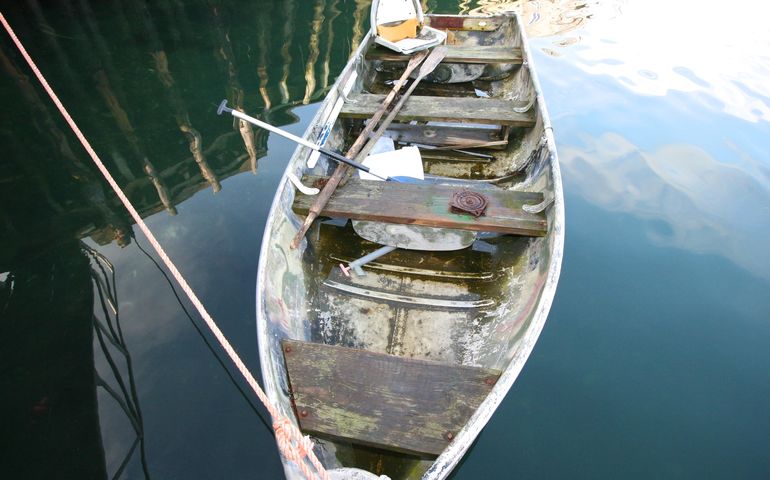Lobstermen to feds: Accelerated whale plan ‘devastating’ to communities
 File photo / Laurie Schreiber
Lobster fishermen this week decried an accelerated timeline to modify industry operations.
File photo / Laurie Schreiber
Lobster fishermen this week decried an accelerated timeline to modify industry operations.
“The economy is going to be devastated here.”
That was Jason Joyce, a Swans Island fisherman who was among scores of lobstermen speaking to federal regulators earlier this week about the impact of an accelerated timeline to reduce the risk of fishing gear and whale interaction by 90%.
A year ago, the National Marine Fisheries Service published Phase 1 measures for its 10-year whale protection plan. The measures were designed to achieve a minimum 60% target reduction in risk within the Northeast American lobster and Jonah crab trap/pot fisheries at the time.
The plan was based on a federal law called the Marine Mammal Protection Act, which allows less than one death per year of the endangered animal, based on its estimated population of fewer than 350.
But given new information since the 2021 modifications were initiated, the risk reduction target increased to at least 90%.
In a recent summary judgment in the Center for Biological Diversity, et al., v. Raimondo, et al., the presiding judge ruled that the 2021 plan failed to satisfy the requirements of the Marine Mammal Protection Act. Given that ruling and the updated 90% risk reduction target, the National Marine Fishery Service determined that additional risk reduction would be necessary.
As of August 2022, researchers determined there were 53 documented incidents of human interactions since 2017. The interactions were observed in U.S. and Canadian waters and included entanglement and vessel strikes.
During the same period, only 55 calves contributed to population growth. With mortalities and serious injuries continuing to outpace births, the population decline continues and further mitigation of entanglements that cause mortality or serious injury is necessary for population recovery, according to the service.
The service said potential risk reduction measures would weaken ropes such as buoy lines; reduce the amount of fishing gear in the water column where right whales occur, either by closing fishing areas or reducing the number of buoy lines; improve identification of the source of entangling gear through increased gear marking; and/or establish or modify seasonal hot-spot management areas.
The service said it was looking for input from the industry on modifications to the plan, as well as about operational challenges, time, and costs regarding restricted areas, gear marking requirements, installation of weak inserts or rope, the use of one endline in offshore areas, the use of acoustic releases of buoys or so-called “ropelesss” fishing gear.
The comment period opened Sept. 9 and closes Oct. 11.
To submit written comments, go to regulations.gov and enter docket No. NOAA-NMFS-2022-0091.
The service held an in-person and virtual “scoping” meeting earlier this week to take comment. Next steps include meetings of the take reduction team, starting in November, to develop measures designed to achieve the 90% target. Public hearings will be held on the modified plan next year, with the goal of implementing the plan in 2024, service staffers said.
In their comments, fishermen said the accelerated timeline and the modifications all together were unnecessary because there has never been a known right whale mortality associated with Maine lobster gear, and there has not been a single known right whale entanglement with Maine lobster gear in nearly two decades.
“This action is gong to be devastating for many Maine communities,” Department of Marine Resources Commissioner Patrick Keliher told the service.
Kristan Porter, president of the Maine Lobstermen’s Association and a member of the take reduction team, said team this past week has been working on possible measures to meet the target
However, he continued, “This is really, really hard. These are measures that are going to really hurt.”
Porter and Keliher decried the accelerated timeframe for working on the plan and getting industry feedback.
“The time is too short,” said Porter.
Virginia Olsen, a Stonington lobster fisherman and a spokesperson with the Maine Lobstering Union in Trenton, said fishermen in her community have little other recourse for work. Stonington is Maine’s biggest lobster port.
“There’s only so many greeters at Walmart,” Olsen said. “We don’t have any depth in our ability to change, to pivot, to go to a different fishery.”
Olsen and others said they’d like to see studies instituted to determine whether whales and fishing gear interact on grounds fished by Maine lobstermen. Suggestions included long-term tagging of right whales to determine their migration patterns, and studies of the distribution of copepods, the tiny crustaceans that right whales feed on.
“There are attributable deaths of right whale on the Atlantic coast, but not in Maine,” Olsen said.
Joyce said the modified plan would wipe out the lobster fishery on Swans Island and other year-round islands and turn them into seasonal communities.
“We’re not going to be a year-round communities,” he said. “I think it’s a shame.”









0 Comments